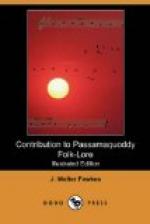E-text prepared by Thierry Alberto, Linda Cantoni, and the Project Gutenberg Online Distributed Proofreading Team (http://www.pgdp.net/)
Note: Project Gutenberg also has an HTML version
of this file
which includes
the original illustrations and sound clips.
See 17997-h.htm
or 17997-h.zip:
(http://www.gutenberg.ne
t/dirs/1/7/9/9/17997/17997-h/17997-h.htm)
or
(http://www.gutenberg.ne
t/dirs/1/7/9/9/17997/17997-h.zip)
Transcriber’s note:
The symbol [=]
followed by a vowel represents a macron.
The symbol [)]
followed by a vowel represents a breve.
Hemenway Southwestern Archaeological Expedition
CONTRIBUTION TO PASSAMAQUODDY FOLK-LORE
by
J. WALTER FEWKES
Reprinted from the Journal of American Folk-Lore, October-December, 1890
A CONTRIBUTION TO PASSAMAQUODDY FOLK-LORE.
The study of aboriginal folk-lore cannot reach its highest scientific value until some method is adopted by means of which an accurate record of the stories can be obtained and preserved. In observations on the traditions of the Indian tribes, the tendency of the listener to add his own thoughts or interpretations is very great. Moreover, no two Indians tell the same story alike. These are sources of error which cannot be eliminated, but by giving the exact words of the speaker it is possible to do away with the errors of the translator.
I believe that the memory of Indians for the details of a story is often better than that of white men. There may be a reason for this, in their custom of memorizing their rituals, stories, and legends. The K[=a]klan, a Zuni ritual, for instance, which is recited by the priest once in four years, takes several hours to repeat. What white man can repeat from memory a history of equal length after so long an interval?
Phonetic methods of recording Indian languages are not wholly satisfactory. It is very unlikely that two persons will adopt the same spelling of a word never heard before. Many inflections, accents, and gutturals of Indian languages are difficult to reduce to writing. Conventional signs and additional letters have been employed for this purpose, the use of which is open to objections. There is need of some accurate method by which observations can be recorded. The difficulties besetting the path of the linguist can be in a measure obviated by the employment of the phonograph, by the aid of which the languages of our aborigines can be permanently perpetuated. As a means of preserving the songs and tales of races which are fast becoming extinct, it is, I believe, destined to play an important part in future researches.




